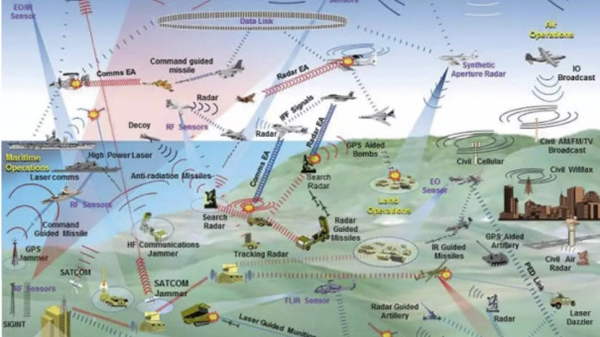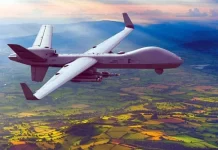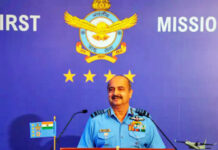Several emerging technologies are expected to have a significant impact on the battlefield of the future. Some of these include:
Artificial Intelligence (AI) and Machine Learning (ML): AI and ML are expected to be increasingly used to improve decision-making, target identification, and battlefield awareness. They could also be used to develop autonomous weapons, which could make warfare more efficient and less reliant on human decision-making.
Autonomous Systems: Unmanned aerial and ground vehicles, as well as underwater drones, are expected to become more prevalent on the battlefield. These systems could be used for reconnaissance, surveillance, and other military tasks, and could greatly enhance the capabilities of military forces.
Directed Energy Weapons (DEW): Lasers and microwave weapons are expected to become more powerful and more widely used in warfare. These weapons could be used to disable or destroy targets at a distance, and could greatly enhance the capabilities of military forces.
Quantum Technology: Quantum computing, quantum communication and quantum encryption are expected to play a major role in future warfare. They could be used to develop more powerful and secure communication systems, as well as to improve intelligence gathering and analysis.
Cybersecurity: As more military systems become connected to the internet, protecting them from cyberattacks will become increasingly important. Emerging technologies such as blockchain and quantum-resistant cryptography are expected to play a key role in securing military networks and systems.
Robotics and Drones: Robotics and drones are expected to play a more prominent role in future warfare, they could be used for reconnaissance, surveillance, and other military tasks including search and rescue, reconnaissance, and explosive ordnance disposal.
Augmented and Virtual Reality (AR/VR): AR/VR are likely to be used for training, simulation, and for enhancing the situational awareness of soldiers on the battlefield.
Hypersonic Weapons: These are missiles that travel at speeds above Mach 5 and can evade traditional missile defense systems.
Space-based Assets: Satellites are being used for a variety of military purposes, including communication, navigation, and intelligence gathering.
Autonomous Systems
India has been actively working on developing autonomous systems and Robotics for defence purposes.
Unmanned Aerial Systems (UAS). The Defence Research and Development Organisation (DRDO) has been developing various UAS for reconnaissance, surveillance, and target acquisition. DRDO’s unmanned aerial vehicle (UAV) Rustom-2 can be used for intelligence, surveillance, and reconnaissance (ISR) missions.
Unmanned Ground Vehicles (UGVs). DRDO has been developing UGVs for a variety of tasks, including explosive ordnance disposal and reconnaissance. DRDO’s UGV named Daksh is capable of handling Improvised Explosive Devices (IEDs). A Minefield Breaching System (MBS) has also been developed, which can be used to clear minefields and other explosive hazards.
Autonomous Naval Systems. Autonomous surface and underwater vehicles for naval applications such as mine countermeasures, anti-submarine warfare, and surveillance are under development. Indian Navy has developed an Autonomous Underwater Vehicle named AUV-62.
Autonomous Weapon Systems. DRDO has been working on autonomous weapon systems for use in air, land and naval defence. These systems are intended to improve decision-making and target identification.
Humanoid Robots. DRDO is also researching the development of humanoid robots for military and civilian applications.
Artificial Intelligence and Machine Learning
AI and ML technologies are being used to improve decision-making, target identification and tracking, predictive maintenance and cybersecurity.
AI-based Decision Support Systems. The Indian armed forces are using AI-based decision support systems to improve situational awareness and decision-making on the battlefield. The Indian Army has developed an AI-based decision support system called the Tactical Control and Analysis System (TCAS).
ML-based Target Identification and Tracking. DRDO has been working on developing ML-based systems for target identification and tracking, for use in air and missile defence. DRDO has developed an ML-based system for tracking and identifying aircraft and missiles, called the Integrated Air Command and Control System (IACCS).
AI-based Predictive Maintenance. India’s armed forces are using AI-based predictive maintenance systems to improve the maintenance of weapons and equipment. The Indian Navy has developed an AI-based predictive maintenance system called the Automatic Maintenance Management System (AMMS).
AI-based Cyber Security. AI and ML has been in use to improve cybersecurity, including intrusion detection and response, and threat intelligence.
AI-based Autonomous Systems. DRDO is been researching the use of AI to improve the autonomy and decision-making capabilities of unmanned systems, including UAVs and UGVs.
Hypersonic Weapons
India is actively researching and developing hypersonic weapons technology, including the Hypersonic Technology Demonstration Vehicle (HSTDV), the BrahMos-II missile, and the Hypersonic Air-breathing Weapon Concept (HAWC). India has also successfully tested a hypersonic scramjet engine, which is a key technology for hypersonic propulsion.
HSTDV can be used to test and validate hypersonic propulsion technologies. BrahMos-II is an upgraded version of BrahMos supersonic cruise missile, designed to be able to travel at hypersonic speeds. HAWC will be a new class of missile that can travel at hypersonic speeds and carry conventional or nuclear payloads.
India has successfully tested a hypersonic scramjet engine. This technology will be used to power the HSTDV and the HAWC.
Directed Energy Weapons
India is actively researching and developing directed energy weapons (DEW), such as high-energy laser systems and microwave weapons, for use in air and missile defense, electronic warfare, and communications.
High-energy Laser Systems. DRDO has been researching and developing high-energy laser systems to disable or destroy incoming missiles and aircraft. DRDO is also working on microwave weapons for use in electronic warfare. These weapons can be used to disrupt or damage electronic systems, such as radar and communications systems.
Laser-based Communication System. The Department of Space has been developing a laser-based communication system that uses a beam of laser light to transmit data through the atmosphere.
Solid-state Laser Technology. DRDO is also working on solid-state laser technology for use in high-energy laser systems.
Space-based Assets
India has been developing a variety of space-based assets for military use, including communication, navigation and reconnaissance satellites, military satellite launch vehicles and space-based early warning systems.
Communication Satellites. Indian Space Research Organisation (ISRO) has developed a number of communication satellites that can be used for military and civilian purposes.
Navigation Satellites. ISRO has developed a regional satellite navigation system called NAVIC (Navigation with Indian Constellation) which provides accurate positioning and timing information for military and civilian use.
Reconnaissance Satellites. ISRO has developed a number of reconnaissance satellites that can be used for intelligence gathering, surveillance and reconnaissance. These include the Cartosat series of satellites which provide high-resolution imagery.
Military Satellite Launch Vehicles. The Polar Satellite Launch Vehicle (PSLV) and the Geosynchronous Satellite Launch Vehicle (GSLV) are used to launch military and civilian satellites into orbit.
Space-based Early Warning Systems. Space-based early warning systems is being developed to detect and track incoming ballistic missiles, and other potential threats to Indian airspace.
Quantum Communication and Quantum Computing
In summary, India is actively researching and developing Quantum communication and Quantum computing technology for defence applications, with a focus on Quantum key distribution, quantum computing, quantum random number generator, and quantum communication network. DRDO and Indian Institute of Technology (IIT), Indian Institute of Science (IISc) have been leading the development of these technologies.
QKD uses the principles of quantum mechanics to generate and distribute cryptographic keys, making it extremely difficult to hack.
DRDO has been researching the use of quantum computing for cryptography, simulation and optimization. A quantum random number generator has been developed that can be used for cryptographic applications, such as key generation and encryption. Indian Institute of Technology (IIT) and Indian Institute of Science (IISc) are also actively researching and developing quantum computing technology.
Quantum Communication Network. DRDO is also researching the development of a quantum communication network that would be able to transmit information securely using quantum cryptography.
Critical Technologies for Next-gen Fighter Aircraft
Several critical technologies are required for military aerospace and next-gen fighter aircraft. These include:
• Stealth technology by reducing the radar cross-section of an aircraft to make it more difficult to detect by radar. This can be achieved through the use of advanced materials and shaping techniques.
• Avionics systems that can integrate and process a large amount of data from various sensors, including radar, infrared, and electronic warfare systems, to improve situational awareness and decision-making.
• Supersonic and hypersonic propulsion that enable aircraft to fly at supersonic or hypersonic speeds, greatly increasing their speed and range, as well as their ability to evade enemy defences.
• Directed energy weapons like laser and microwave weapons that can be used to disable or destroy enemy aircraft, missiles and other targets.
• The use of advanced materials, such as composites, that can withstand high temperatures and stresses, as well as structures that can withstand high-g manoeuvres are critical for next-generation fighter aircraft.
Complexities Involved in Development of Aeroengines
The development and manufacture of aeroengines is a complex and challenging process that involves a number of technical, logistical, and financial complexities. Some of the major complexities involved in this process include:
Advanced Materials and Manufacturing Techniques. Aeroengines are made from a variety of materials, including metals, ceramics, and composites, which must be engineered and manufactured to exacting tolerances to withstand the high temperatures, pressures, and loads encountered in flight.
Complex Design and Engineering. Aeroengines are highly complex systems that require advanced design and engineering techniques to optimize performance, efficiency, and reliability. This includes the use of computational fluid dynamics, finite element analysis, and other advanced simulation tools to model and optimize the engine’s performance.
High Development and Manufacturing Costs. Developing and manufacturing aeroengines is an extremely costly process, involving significant investments in research and development, engineering, testing, and production facilities.
Critical Technologies for Next-gen Armoured Fighting Vehicles
Some critical technologies for next generation armoured fighting vehicles include:
• Active protection systems (APS) which detect and intercept incoming projectiles before they can hit the vehicle.
• Advanced armour materials, such as ceramic and composite materials, that can provide better protection against high-powered weapons.
• Electric drive systems and hybrid powertrains to improve mobility and reduce dependence on fossil fuels.
• Advanced sensors and networking systems to improve situational awareness and communication among vehicles and with command and control centres.
• Autonomous capabilities such as autonomy and artificial intelligence to improve decision-making and reduce the risk to crew members.
• Stealth technology to reduce the vehicle’s detectability by enemy sensors.
• Laser weapons, directed energy weapons, to provide longer range and more precise firepower.
Critical Technologies for Next-gen Submarines
Next-gen submarines require some critical technologies as follows:
• Advanced stealth technology to reduce the submarine’s detectability by enemy sensors. This includes quieting systems for the propulsion, electrical and mechanical systems, as well as hull coatings and designs that minimize the submarine’s acoustic, magnetic and electromagnetic signatures.
• AIP (air-independent propulsion) systems that allow the submarine to operate for extended periods without surfacing. This can include fuel cells, closed-cycle diesel engines, or Stirling engines.
• Advanced sensors, including sonar systems, for improved underwater detection and classification of other vessels and submarines.
• Integrated communications and networking systems to improve the submarine’s command, control, and information-sharing capabilities.
• Hybrid electric drive propulsion system that allows extended low-speed operations and silent running, as well as increased range and endurance.
• In the case of next-gen frigates and destroyers, additional technologies, as follows, are required:
• Advanced propulsion systems, such as gas turbine or integrated electric drive, to improve the ship’s speed, range, and manoeuvrability.
• Advanced sensors, including radar, sonar and electronic warfare systems, for improved situational awareness and threat detection.
• Integrated communications and networking systems to improve the ship’s command, control, and information-sharing capabilities.
• Advanced armour materials and active protection systems to improve the ship’s survivability against incoming projectiles.
Way Ahead
India is a significant player in the defence and aerospace industries, with a strong focus on developing advanced technologies. The country has a robust domestic defence industry, which produces a wide range of military equipment and weapons systems, including tanks, fighter jets, and warships. India also has a growing aerospace industry, with several major companies and research institutions including DRDO working on developing new technologies in areas such as satellite launch vehicles, unmanned aerial vehicles (UAVs), and hypersonic vehicles. Additionally, India has a strong tradition of scientific research, including in areas such as aerodynamics, propulsion, and materials science, which it is leveraging to develop advanced technologies for defence and aerospace applications.
To further enhance its capabilities and catch up with the world leaders in advanced technologies, India should increase investment in research and development; encourage collaboration and partnerships between its defence and aerospace companies, research institutions, and international partners; create a conducive policy environment (funding, tax incentives, and other benefits); increase indigenization with a focus on building capabilities in design, development, and production of defence equipment; and emphasize on education and training (science, technology, engineering, and mathematics).



















